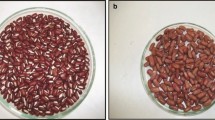Abstract
A purple acid phosphatase was purified to homogeneity from Euphorbia characias latex. The native protein has a molecular mass of 130 ± 10 kDa and is formed by two apparently identical subunits, each containing one Fe(III) and one Zn(II) ion. The two subunits are connected by a disulfide bridge. The enzyme has an absorbance maximum at 540 nm, conferring a characteristic purple color due to a charge-transfer transition caused by a tyrosine residue (Tyr172) coordinated to the ferric ion. The cDNA nucleotide sequence contains an open reading frame of 1392 bp, and the deduced sequence of 463 amino acids shares a very high degree of identity (92–99%) to other purple acid phosphatases isolated from several higher plants. The enzyme hydrolyzes well p-nitrophenyl phosphate, a typical artificial substrate, and a broad range of natural phosphorylated substrates, such as ATP, ADP, glucose-6-phosphate, and phosphoenolpyruvate. The enzyme displays a pH optimum of 5.75 and is inhibited by molybdate, vanadate, and Zn2+, which are typical acid phosphatase inhibitors.
Similar content being viewed by others
Abbreviations
- AP:
-
acid phosphatases
- ELPAP:
-
Euphorbia latex purple acid phosphatase (protein)
- PAPs:
-
purple acid phosphatases
- p-NPP:
-
4-nitrophenyl phosphate
- RT-PCR:
-
reverse transcription-polymerase chain reaction
- SDS-PAGE:
-
sodium dodecyl sulfate polyacrylamide gel electrophoresis
References
Klabunde, T., Strater, N., Krebs, B., and Witzel, H. (1995) FEBS Lett., 367, 56–60.
Hoehamer, C. F., Mazur, C. S., and Wolfe, N. L. (2005) J. Agric. Food Chem., 53, 90–97.
Strater, N., Frohlich, R., Schiemann, A., Krebs, B., Korner, M., Suerbaum, H., and Witzel, H. (1992) J. Mol. Biol., 224, 511–513.
Klabunde, T., Strater, N., Frohlich, R., Witzel, H., and Krebs, B. (1996) J. Mol. Biol., 259, 737–748.
Ehsanpour, A. A., and Amini, F. (2003) Afr. J. Biotechnol., 5, 133–135.
Wilcox, D. E. (1996) Chem. Rev., 96, 2435–2458.
Olczak, M., Ciuraszkiewicz, J., Wojtowicz, H., Maszczak, D., and Olczak, T. (2009) FEBS Lett., 583, 3280–3284.
Olczak, M., and Watorek, W. (2003) Physiol. Plant., 118, 491–498.
Olczak, M., Morawiecka, B., and Watorek, W. (2003) Acta Biochim. Pol., 50, 1245–1256.
Pintus, F., Spano, D., Bellelli, A., Angelucci, F., Floris, G., and Medda, R. (2009) Plant Sci., 177, 636–642.
Gabriel, O. (1971) in Methods in Enzymology (Jakoby, W. B., ed.) Vol. 22, Academic Press, New York, pp. 565–578.
Weber, K., and Osborne, M. (1969) J. Biol. Chem., 244, 4406–4412.
Gelotte, B. (1960) J. Chromatogr., 3, 330–342.
Bradford, M. M. (1976) Anal. Biochem., 72, 248–254.
Rose, T. M., Henikoff, J. G., and Henikoff, S. (2003) Nucleic Acids Res., 31, 3763–3766.
Frohman, M. A. (1993) Meth. Enzymol., 218, 340–356.
Veljanovski, V., Vanderbeld, B., Knowles, V. L., Snedden, W. A., and Plaxton, W. C. (2006) Plant Physiol., 142, 1282–1293.
Author information
Authors and Affiliations
Corresponding author
Additional information
Published in Russian in Biokhimiya, 2011, Vol. 76, No. 6, pp. 849–857.
These authors contributed equally to this work.
Rights and permissions
About this article
Cite this article
Pintus, F., Spano, D., Corongiu, S. et al. Purification, primary structure, and properties of Euphorbia characias latex purple acid phosphatase. Biochemistry Moscow 76, 694–701 (2011). https://doi.org/10.1134/S0006297911060101
Received:
Revised:
Published:
Issue Date:
DOI: https://doi.org/10.1134/S0006297911060101




